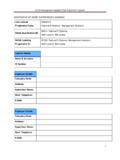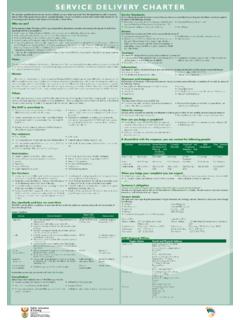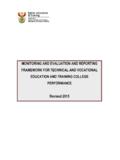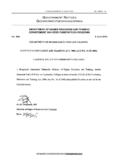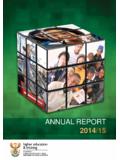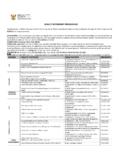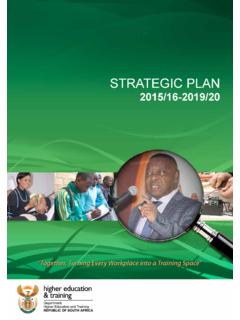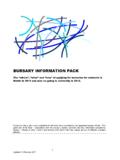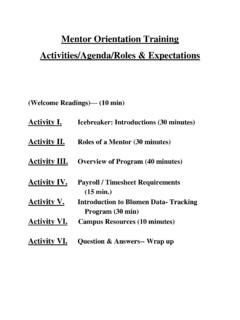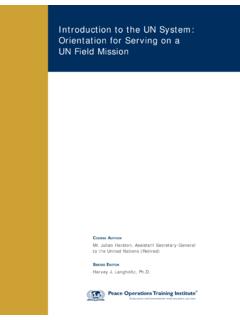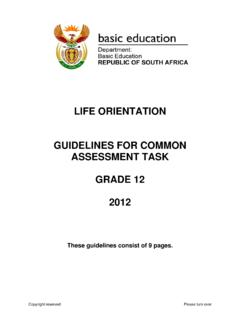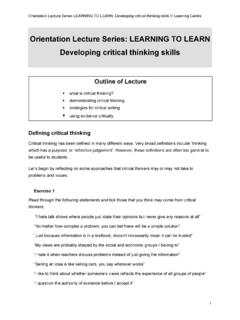Transcription of NATIONAL CERTIFICATES (VOCATIONAL) ASSESSMENT …
1 NATIONAL CERTIFICATES ( vocational ) ASSESSMENT GUIDELINES life orientation NQF LEVEL 3 IMPLEMENTATION: JANUARY 2014 life orientation (Level 3) Final ASSESSMENT Guidelines (January 2014) NATIONAL CERTIFICATES ( vocational ) 1 Department of Higher Education and Training CONTENTS SECTION A: PURPOSE OF THE ASSESSMENT GUIDELINES SECTION B: ASSESSMENT IN THE NATIONAL CERTIFICATES ( vocational ) 1 ASSESSMENT in the NATIONAL CERTIFICATES ( vocational ) 2 ASSESSMENT framework for vocational qualifications Internal continuous ASSESSMENT (ICASS) External summative ASSESSMENT (ESASS) 3 Moderation of ASSESSMENT Internal moderation External moderation 4 Period of validity of internal continuous ASSESSMENT (ICASS) 5 Assessor requirements 6 Types of ASSESSMENT Baseline ASSESSMENT Diagnostic ASSESSMENT Formative ASSESSMENT Summative ASSESSMENT 7 Planning ASSESSMENT Collecting evidence Recording Reporting 8 Methods of ASSESSMENT 9 Instruments and tools for collecting evidence 10 Tools for assessing student performance 11 Selecting and/or designing recording and reporting systems 12 Competence descriptions 13 Strategies for collecting evidence Record sheets Checklists SECTION C: ASSESSMENT IN life orientation 1 ASSESSMENT schedule and requirements 2 Recording and reporting 3 Internal ASSESSMENT of Subject Outcomes in life orientation Level 3 Topics for internal ASSESSMENT in Portfolio of Evidence (PoE) 4 Specifications for the external ASSESSMENT in life orientation Level 3 ANNEXURE A.
2 Guidelines for marking assignments life orientation (Level 3) Final ASSESSMENT Guidelines (January 2014) NATIONAL CERTIFICATES ( vocational ) 2 Department of Higher Education and Training SECTION A: PURPOSE OF THE SUBJECT ASSESSMENT GUIDELINES This document provides the lecturer with guidelines to develop and implement a coherent, integrated ASSESSMENT system for life orientation in the NATIONAL CERTIFICATES ( vocational ). It must be read with the NATIONAL Policy Regarding Further Education and Training Programmes: Approval of the Documents, Policy for the NATIONAL CERTIFICATES ( vocational ) Qualifications at Levels 2 to 4 on the NATIONAL Qualifications Framework (NQF). This document explains the requirements for the internal and external subject ASSESSMENT . The lecturer must use this document with the Subject Guidelines: life orientation Level 3 to prepare for and deliver the subject.
3 Lecturers should use a variety of resources and apply a range of ASSESSMENT skills in the setting, marking and recording of ASSESSMENT tasks. SECTION B: ASSESSMENT IN THE NATIONAL CERTIFICATES ( vocational ) 1 ASSESSMENT IN THE NATIONAL CERTIFICATES ( vocational ) ASSESSMENT in the NATIONAL CERTIFICATES ( vocational ) is underpinned by the objectives of the NATIONAL Qualifications Framework (NQF). These objectives are to: Create an integrated NATIONAL framework for learning achievements. Facilitate access to and progression within education, training and career paths. Enhance the quality of education and training. Redress unfair discrimination and past imbalances and thereby accelerate employment opportunities. Contribute to the holistic development of the student by addressing: social adjustment and responsibility; moral accountability and ethical work orientation ; economic participation; and nation-building.
4 The principles that drive these objectives are: Integration To adopt a unified approach to education and training that will strengthen the human resources and develop the capacity of the nation. Relevance To be dynamic and responsive to NATIONAL development needs. Credibility To demonstrate recognition of competencies and skills acquired, NATIONAL and international added value and recognition of the acquired qualification Coherence To work within a consistent framework of principles and certification. Flexibility To allow for creativity and resourcefulness when achieving Learning Outcomes, to cater for different learning styles and use a range of ASSESSMENT methods, instruments and techniques. Participation To enable stakeholders to participate in the setting of standards and the co-ordination of the achievements required for the qualification. Access To address barriers to learning experienced on different levels and to facilitate the students progress.
5 life orientation (Level 3) Final ASSESSMENT Guidelines (January 2014) NATIONAL CERTIFICATES ( vocational ) 3 Department of Higher Education and Training Progression To ensure the qualification framework permits individuals to move through the levels of the NATIONAL qualification via different, appropriate combinations of the components of the delivery system. Portability To enable students to transfer credits obtained within a qualification from one learning institution and/or employer to another institution or employer. Articulation To allow for vertical and horizontal mobility in the educational system on condition that accredited pre-requisites have been successfully completed. Recognition of Prior Learning To grant credits for a unit of learning following an ASSESSMENT process or where a student possesses the capabilities as specified in the outcomes.
6 Validity of assessments To ensure ASSESSMENT covers a broad range of knowledge, skills, values and attitudes (SKVAs) need to demonstrate applied competency. This is achieved through: clearly stating the outcome to be assessed; selecting the appropriate or suitable evidence; matching the evidence with a compatible or appropriate method of ASSESSMENT ; and selecting and constructing an instrument(s) of ASSESSMENT . Topics should be assessed individually and then cumulatively with other topics. There should be a final summative internal ASSESSMENT prior to the external ASSESSMENT . Reliability To assure ASSESSMENT practices are consistent so that the same result or judgment is arrived at if the ASSESSMENT is replicated in the same context. This demands consistency in the interpretation of evidence; therefore, careful monitoring of ASSESSMENT is vital.
7 Cumulative and summative assessments must be weighted more than single topic tests for the internal mark. There should be at least one standardised or norm test in each term. All standardised or norm tests must be moderated by a subject specialist. Fairness and transparency To verify that ASSESSMENT processes and/or method(s) used neither hinder nor unfairly advantage any student. The following could constitute unfairness in ASSESSMENT : Inequality of opportunities, resources or teaching and learning approaches Bias based on ethnicity, race, gender, age, disability or social class Lack of clarity regarding Learning Outcome being assessed Comparison of students work with other students, based on learning styles and language ASSESSMENT in life orientation must take into consideration that the process or method carries more weight than the final answer. Practicability and cost-effectiveness To integrate ASSESSMENT tasks and/practices within an outcomes-based education and training system to strive for cost and time-effective ASSESSMENT .
8 life orientation (Level 3) Final ASSESSMENT Guidelines (January 2014) NATIONAL CERTIFICATES ( vocational ) 4 Department of Higher Education and Training 2 ASSESSMENT FRAMEWORK FOR vocational QUALIFICATIONS The ASSESSMENT structure for the NATIONAL CERTIFICATES ( vocational ) qualification is as follows: Internal continuous ASSESSMENT (ICASS) Knowledge, skills, values, and attitudes (SKVAs) are assessed throughout the year using ASSESSMENT instruments such as projects, tests, assignments, investigations, role-play and case studies. All internal continuous ASSESSMENT (ICASS) evidence is kept in a Portfolio of Evidence (PoE) and must be readily available for monitoring, moderation and verification purposes. This component is moderated and quality assured both internally and externally. External summative ASSESSMENT (ESASS) The external summative ASSESSMENT comprises TWO papers set to meet the requirements of the Subject and Learning Outcomes.
9 It is administered according to relevant ASSESSMENT policies and requirements. External summative assessments will be conducted annually between October and December, with provision made for supplementary sittings. 3 MODERATION OF ASSESSMENT Internal moderation ASSESSMENT must be moderated according to the internal moderation policy of the Further Education and Training (FET) College. Internal college moderation is a continuous process. The moderator s involvement starts with the planning of ASSESSMENT methods and instruments and follows with continuous collaboration with and support to the assessors. Internal moderation creates common understanding of ASSESSMENT Standards and maintains these across vocational programmes. External moderation External moderation is conducted according to relevant quality assurance bodies standards, policies, and requirements (currently the South African Qualifications Authority [SAQA] and Umalusi).
10 The external moderator: monitors and evaluates the standard of all summative assessments; maintains standards by exercising appropriate influence and control over assessors; ensures proper procedures are followed; ensures summative integrated assessments are correctly administered; observes a minimum sample of ten (10) to twenty-five (25) percent of summative assessments; gives written feedback to the relevant quality assurer; and moderates in case of a dispute between an assessor and a student. Policy on inclusive education requires that ASSESSMENT procedures for students who experience barriers to learning be customised and supported to enable these students to achieve their maximum potential. 4 PERIOD OF VALIDITY OF INTERNAL CONTINUOUS ASSESSMENT (ICASS) The period of validity of the internal continuous ASSESSMENT mark is determined by the NATIONAL Policy on the Conduct, Administration and Management of the ASSESSMENT of the NATIONAL CERTIFICATES ( vocational ).
